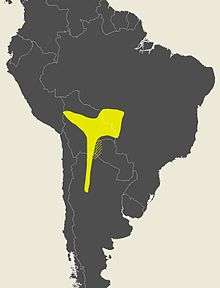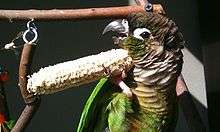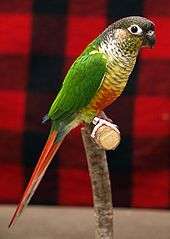Green-cheeked parakeet
The green-cheeked conure (Pyrrhura molinae) is a small parrot of the genus Pyrrhura, which is part of a long-tailed group of the New World parrot subfamily Arinae. This type of parrot is generally called a conure in aviculture. It is native to the forests of South America.
| Green-cheeked parakeet | |
|---|---|
 | |
| Yellow Sided Conure caged bird Bangladesh | |
| Scientific classification | |
| Kingdom: | Animalia |
| Phylum: | Chordata |
| Class: | Aves |
| Order: | Psittaciformes |
| Family: | Psittacidae |
| Genus: | Pyrrhura |
| Species: | P. molinae |
| Binomial name | |
| Pyrrhura molinae | |
 | |
| Approximate range. Now also confirmed for lined area[1][2] | |
Description
The green-cheeked conure is typically 26 cm (10 in) long and weighs 60 to 80 g. It is mainly green, with a brown/black/grey crown, white periophthalmic rings, green cheeks, blue primary wing feathers, a grey beak, and its long pointed tail is mostly maroon. It has short transverse striations on its breast and a red abdominal area. Males and females have an identical external appearance.[3]
Taxonomy
The green-cheeked conure has six subspecies:[3][4]
- Pyrrhura molinae, (Massena & Souance 1854)
- P. m. australis, Todd 1915
- P. m. flavoptera, Maijer, Herzog, Kessler, Friggens & Fjeldsa 1998
- P. m. hypoxantha,(Salvadori 1899)
- P. m. molinae, (Massena & Souance 1854)
- P. m. phoenicura, (Schlegel 1864)
- P. m. restricta, Todd 1947
P. m. sordida naturally occurs as a common green morph or as a rare yellow morph (which however is more frequent in captivity).[3][5][6] The yellow morph is also called the yellow-sided conure[7] and was once erroneously considered to be a separate species, P. hypoxantha.[8] As P. hypoxantha was described before P. m. sordida the older name goes first, therefore P. m. sordida is called P. m. hypoxantha these days.
The green-cheeked conure is similar to the maroon-bellied parakeet (P. frontalis),[7] and formerly there have been speculations that they were conspecific.[8] It is also similar in appearance to the blaze-winged parakeet and the black-capped parakeet.[7]
Distribution and habitat
The green-cheeked conure occurs in west-central and southern Mato Grosso, Brazil, northern and eastern Bolivia, northwestern Argentina, and western Paraguay.[2][5][8] Its habitat is forests and woodland, where it usually forms flocks of 10 to 20 individuals at treetop level, or larger flocks where there is more food. It is also emerging as a popular pet for families and individuals.[7]
Diet and behavior

The green-cheeked conure eats various seeds, vegetables and fruits. The average clutch is 4–6 eggs. Average incubation is 25 days, varying from 22 to 25 days. They are the quietest of the conures and can learn tricks and have a limited vocabulary, with extensive training.[9]
Aviculture

Green-cheeked parrots are common in aviculture and are popular companion parrots. They are playful, affectionate and intelligent, known as having a "big personality in a small body". They can learn to talk, albeit with a limited vocabulary and a gravelly voice.[10] They like to be held (although some like it more than others) and can learn tricks such as lying on their backs, "kissing," shaking, hanging upside down and even can be potty trained. Green-cheeked parrots are not very loud at most times, so even an apartment dweller can enjoy their companionship.[11] They can be prone to biting, particularly when young, but an owner can cure this behavior with patience and time.
They love fruits, (especially bananas and raisins), and seeds such as sunflower, safflower, and hemp seeds—all found in their natural environments. Green-cheeked parrots also love table food—they are flock animals and love to eat with their family. They can eat potatoes, carrots, corn, bread, pasta, and plain popcorn. A clipped and/or caged bird can become obese from eating too many fatty seeds such as sunflower seeds and peanuts. A bird-pellet diet with a calcium supplement provides proper nutrition and should comprise 60–70% of their diet.[12] An ideal diet is 70% pellet, 20% fruit and vegetables and <10% treat items. Parrots with health problems related to the kidneys should not be fed a high protein diet, as it may lead to gout;[13] veterinarian prescribed low-protein diets are available for birds with such conditions. Green-cheeked parrots can live to 30 years with proper care, though the average lifespan is typically 10 years due to owner neglect.[14]
Color Variations
In addition to the natural color forms, color varieties have been selectively bred in aviculture:
- Cinnamon are lime green and have a lighter, almost pale color to the feathers. The head is tan and the tail feathers are a lighter maroon than in normal green-cheeked parrots.
- Yellow-sided have a breast of bright colors and, rarely, have a bright yellow feather on each side of the upper wing. This is a rare recessive character of which only one hatchling in approximately 10 clutches can be found to have. This appearance can increase their value.
- Pineapple is cinnamon and yellow-sided combination. They have a breast of bright colors, a tan head and lime green feathers on the back like a cinnamon green-cheeked parrot. The tail feathers are the same as a yellow-sided, showing a halo effect.
- Turquoise have a body with some blue-green and green feathers.The end of the wing feathers if left un clipped have a highly iridescent quality. The breast feathers are grayish and the tail feathers are gray.
_-KL_Bird_Park-6a.jpg) Cinnamon mutation
Cinnamon mutation Pineapple mutation (juvenile)
Pineapple mutation (juvenile) Turquoise mutation
Turquoise mutation
(wing-clipped adult) Yellow-sided green-cheek mutation[15]
Yellow-sided green-cheek mutation[15]
A green/red/blue apple variety is not very common but has been seen.
References
- BirdLife International (2012). "Pyrrhura molinae". IUCN Red List of Threatened Species. 2012. Retrieved 26 November 2013.CS1 maint: ref=harv (link)
- Smith, P. (2006). Green-cheeked Parakeet. Fauna Paraguay. Retrieved 1 February 2015.
- Forshaw (2006). plate 85.
- "Zoological Nomenclature Resource: Psittaciformes (Version 9.026)". Zoonomen.net. 2009-07-26.
- Collar, N.J. (1997). Green-cheeked Conure (Pyrrhura molinae), page 440 in: del Hoyo, J.; Elliott, A.; and Sargatal, J., eds. (1997). Handbook of the Birds of the World. Vol. 4. Sandgrouses to Cuckoos. Lynx Edicions, Barcelona. ISBN 84-87334-22-9
- Berlo, B.V. (2009). A Field Guide to the Birds of Brazil. Pages 126–127. Oxford University Press, New York. ISBN 978-0-19-530154-0
- Forshaw (2006). page 114.
- Juniper; Parr (1998). Parrots: A Guide to Parrots of the World. p. 462. ISBN 978-0-300-07453-6.
- Lara. "The Green Cheek Conure Homepage". Gcch.tripod.com. Retrieved 2013-10-17.
- "Green-Cheeked Conure – Pyrrhura molinae". Lafeber. Retrieved 2019-06-20.
- "Specialist Breeders – Birds for Sale – All About Green Cheek Conures". All About Birds. Archived from the original on 2013-04-09. Retrieved 2013-01-15.
- "Green Cheek Conure" (PDF). Petco.com. Retrieved 2013-10-20.
- "Gout in Pet Birds". 2ndchance.info. Retrieved 2013-10-20.
- "Green Cheeked Conure". Central Pets Educational Foundation. Web Archive Copy. Archived from the original on 2008-02-12.
- "Yellow sided green cheek conure". Commons.wikimedia.org. May 2013. Retrieved 2013-10-20.
Works cited
- Forshaw, Joseph M. (2006). Parrots of the World; an Identification Guide. Illustrated by Frank Knight. Princeton University Press. ISBN 978-0-691-09251-5.
- Per CITES Reference and IATA LAR 43rd Edition, these birds are classified to fall under CITES Protected species under categories I and II in the CITES index
External links
| Wikimedia Commons has media related to pyrrhura molinae. |
- Green-Cheeked Conures Lucky Feathers Aviary – Species Profile, Green-Cheeked Conure Care, breeding and Diet Information
- "Green Cheeked Conure". Parrot Encyclopedia. World Parrot Trust.
- "Internet Bird Collection".
